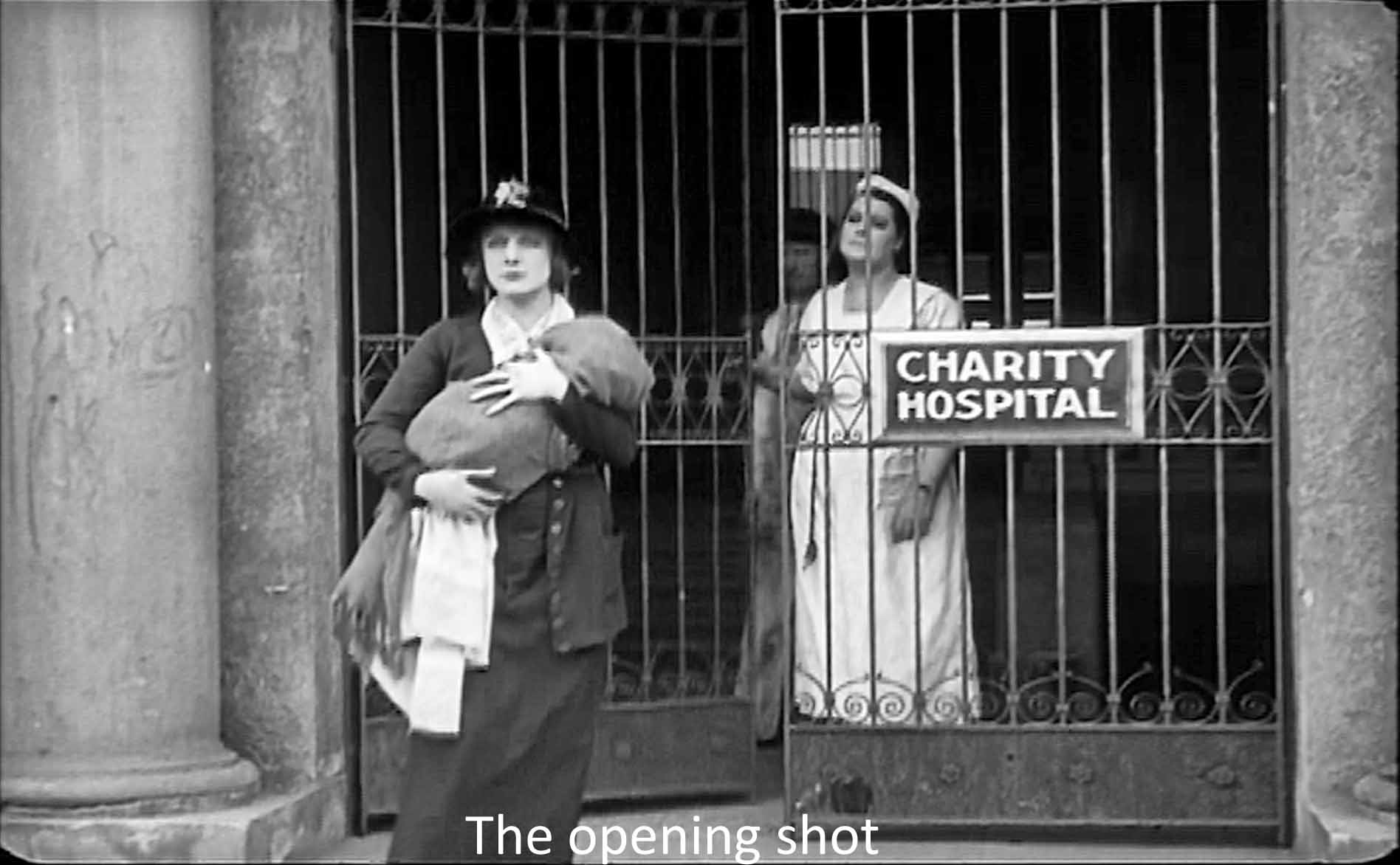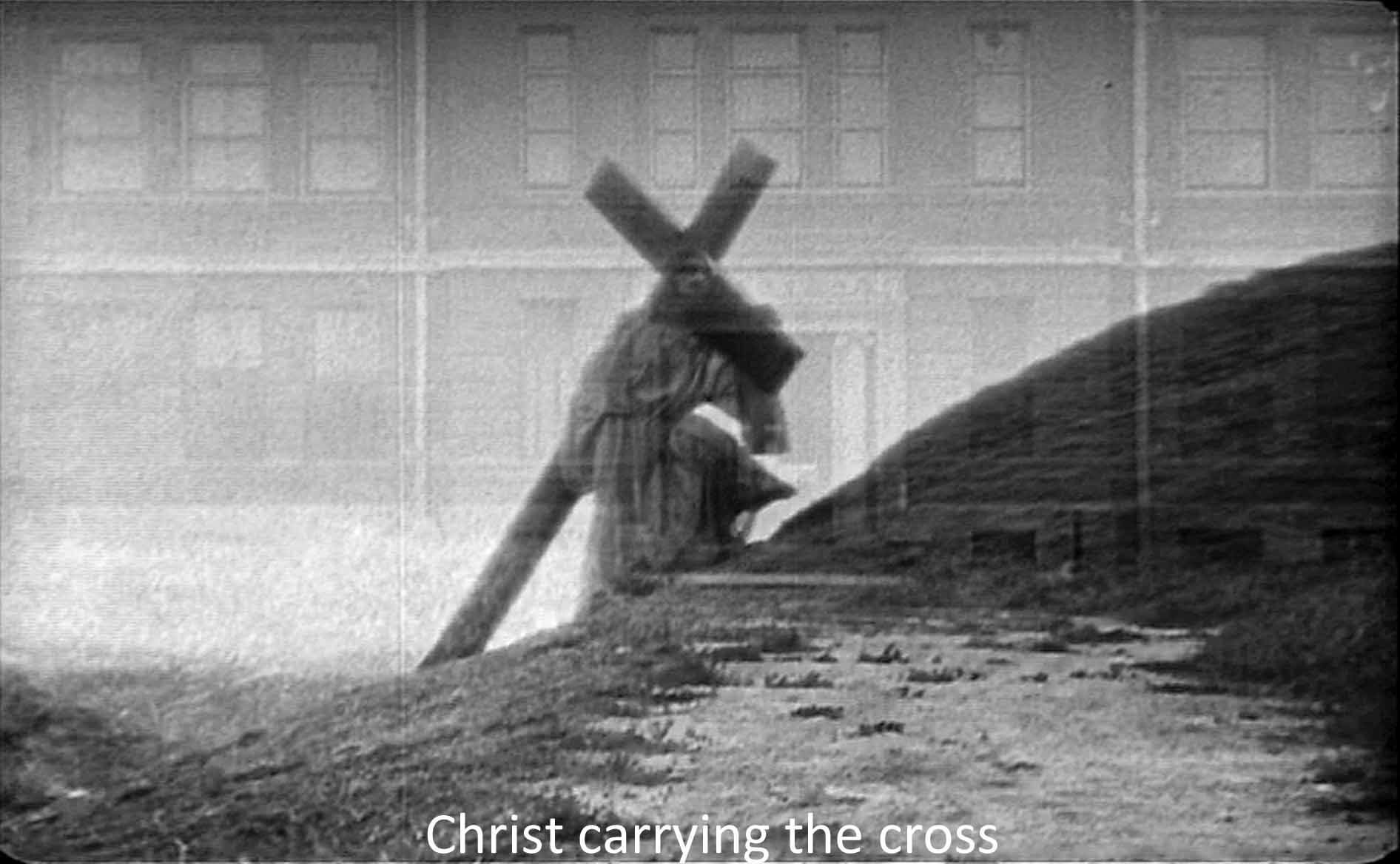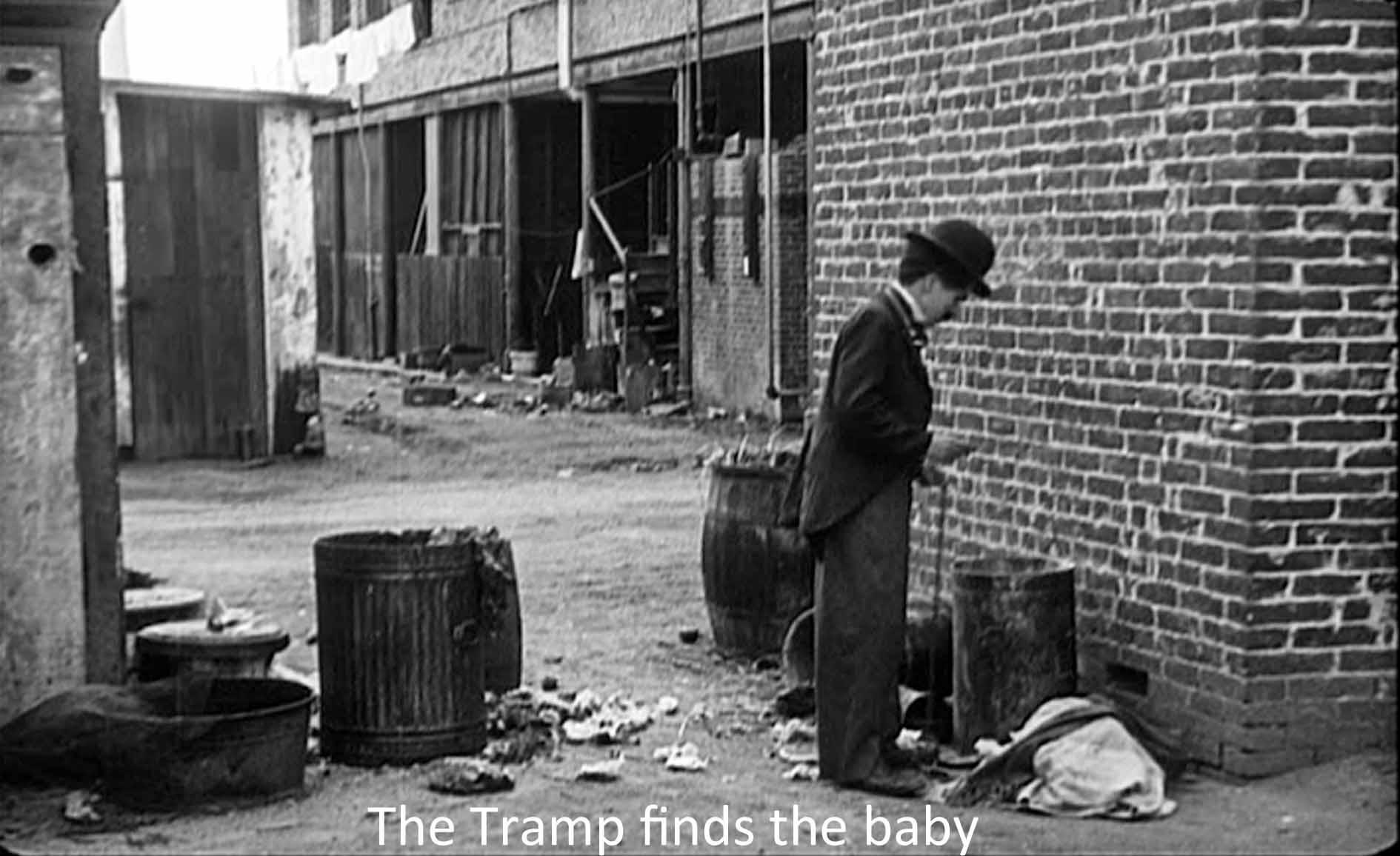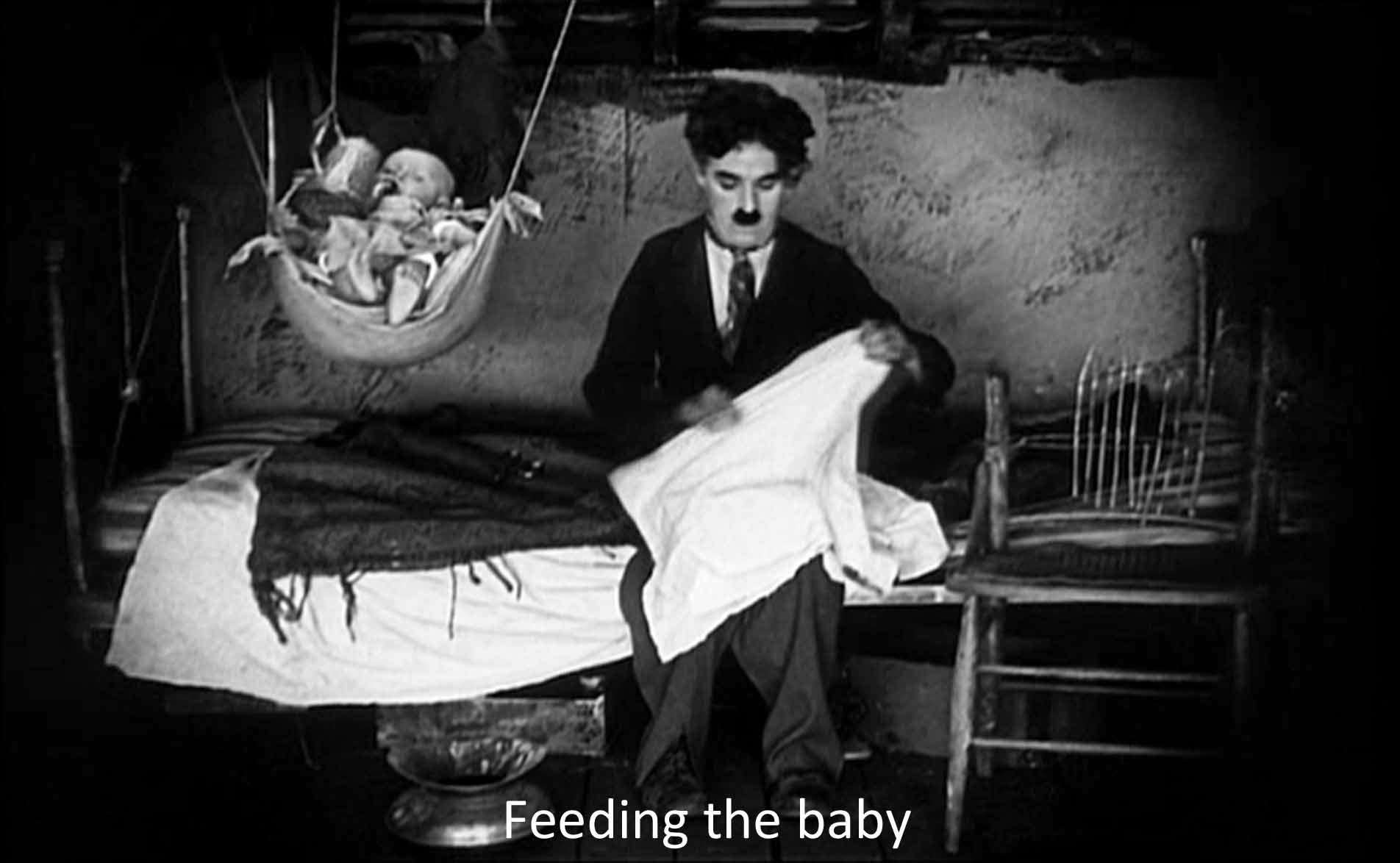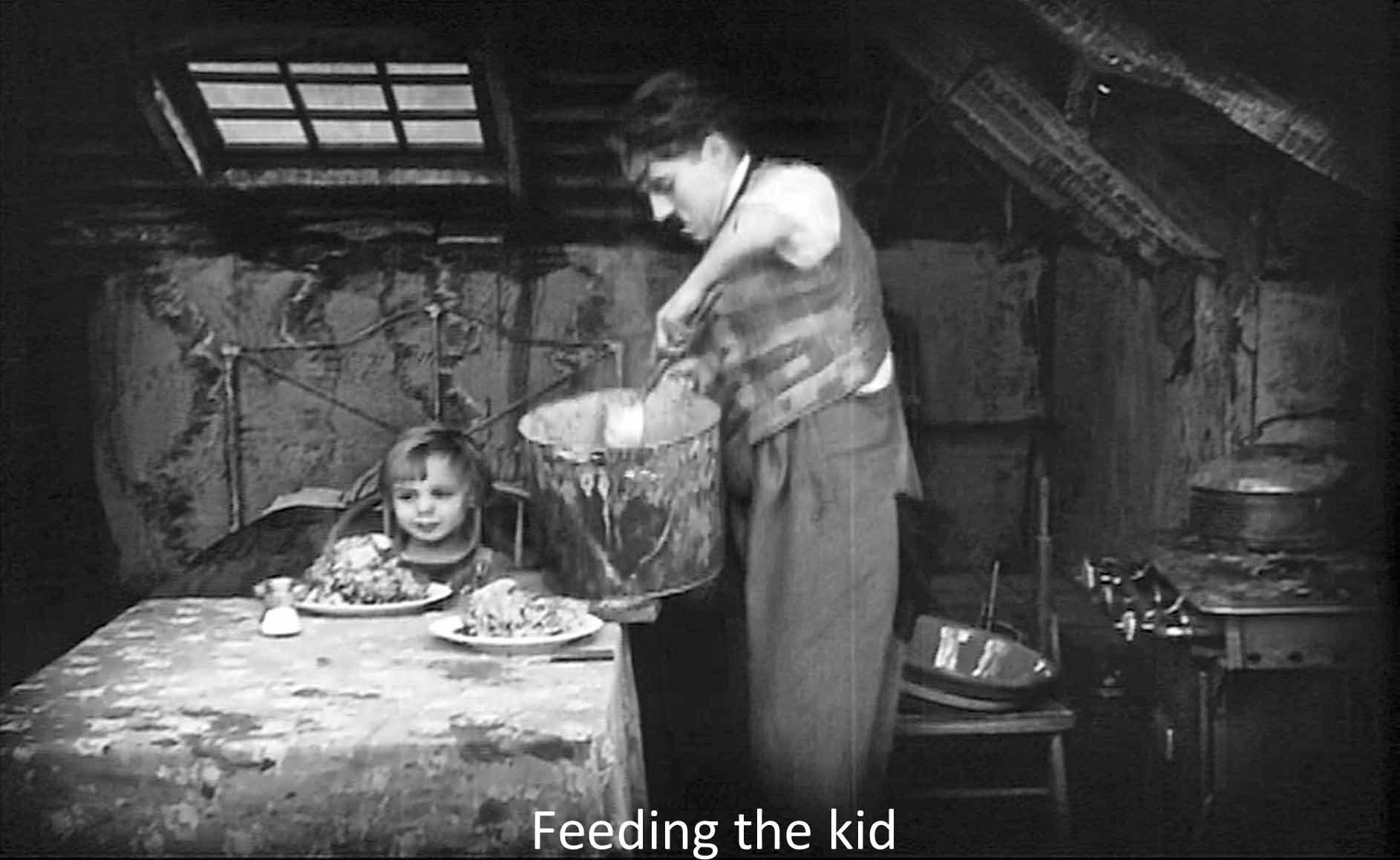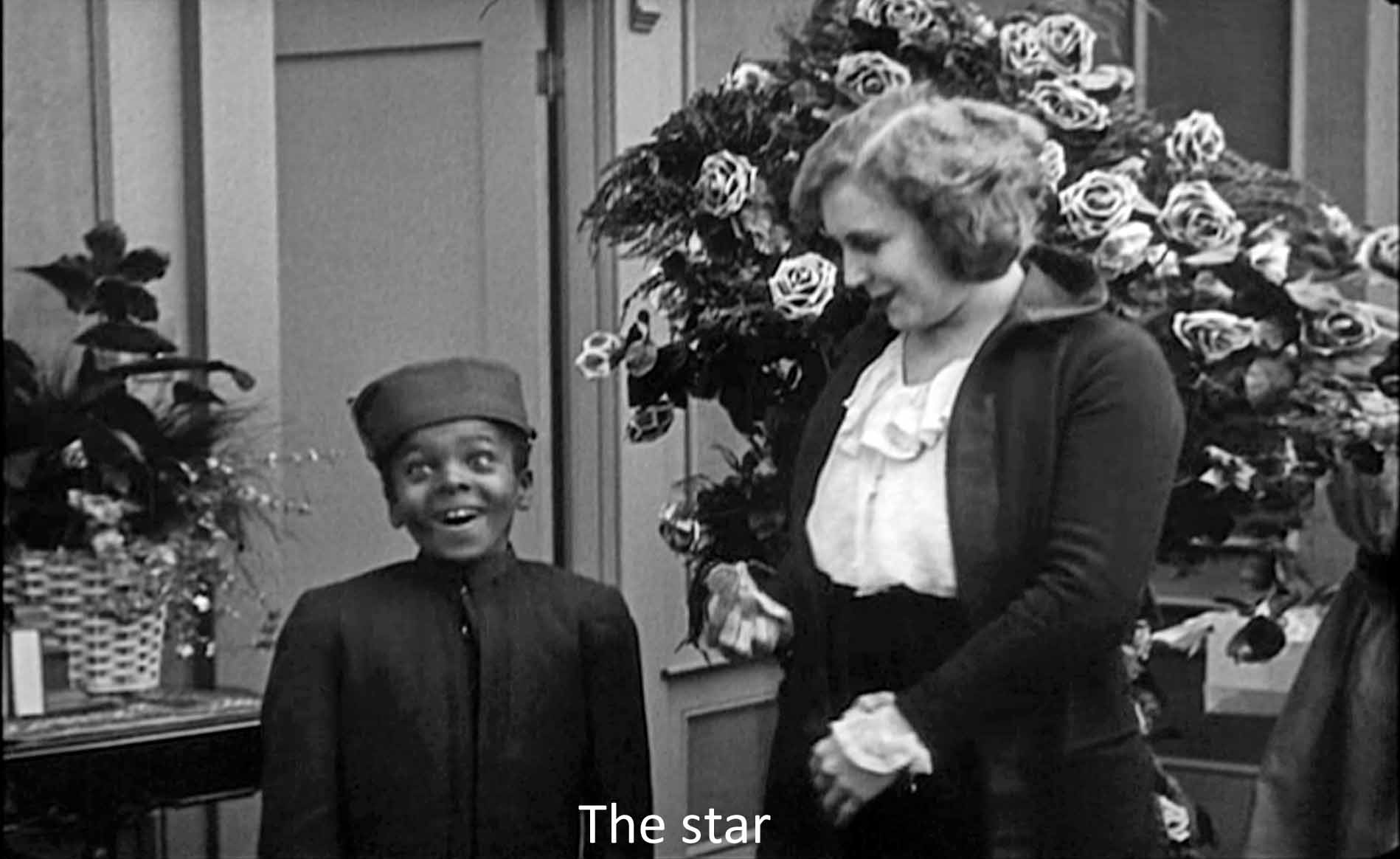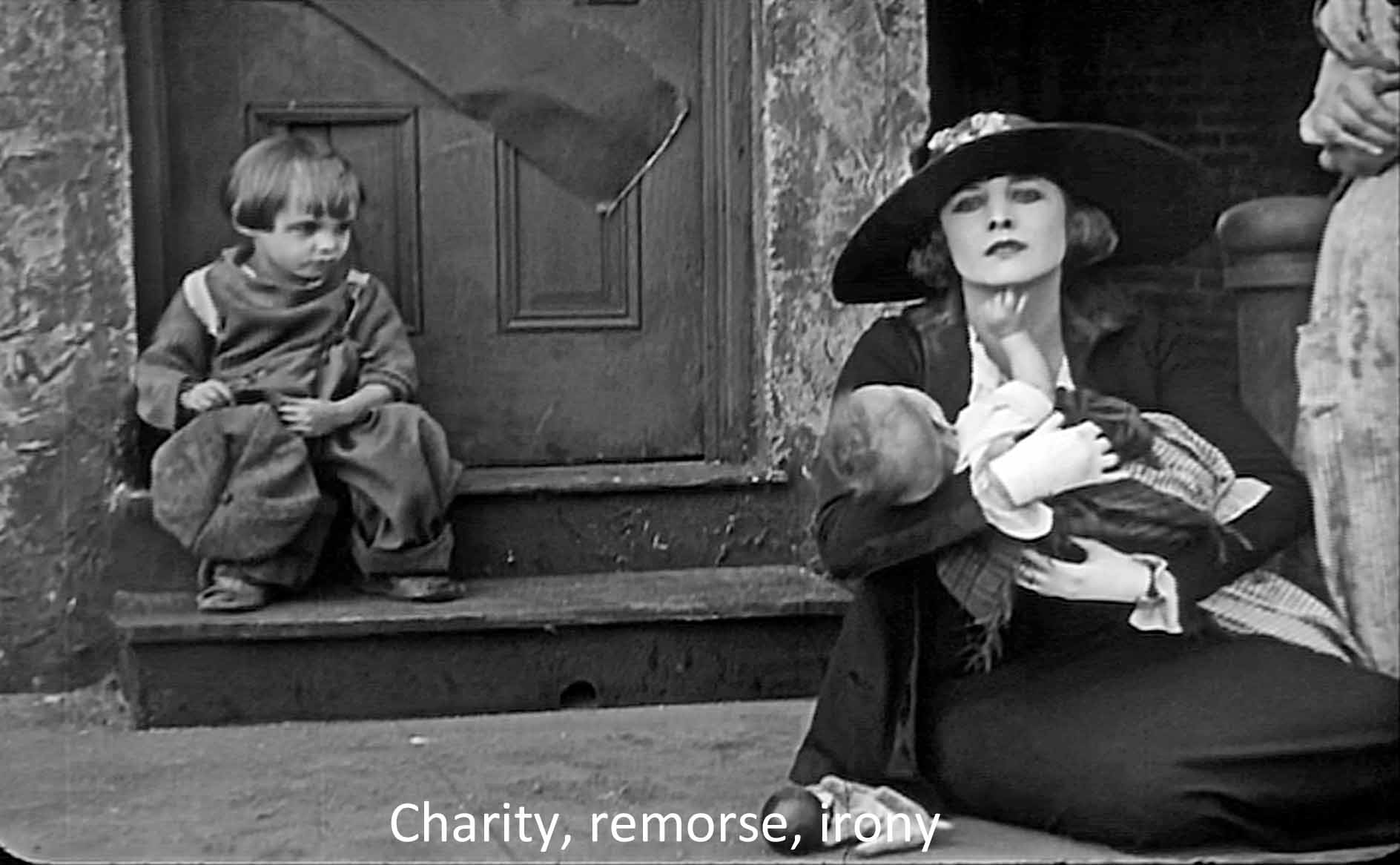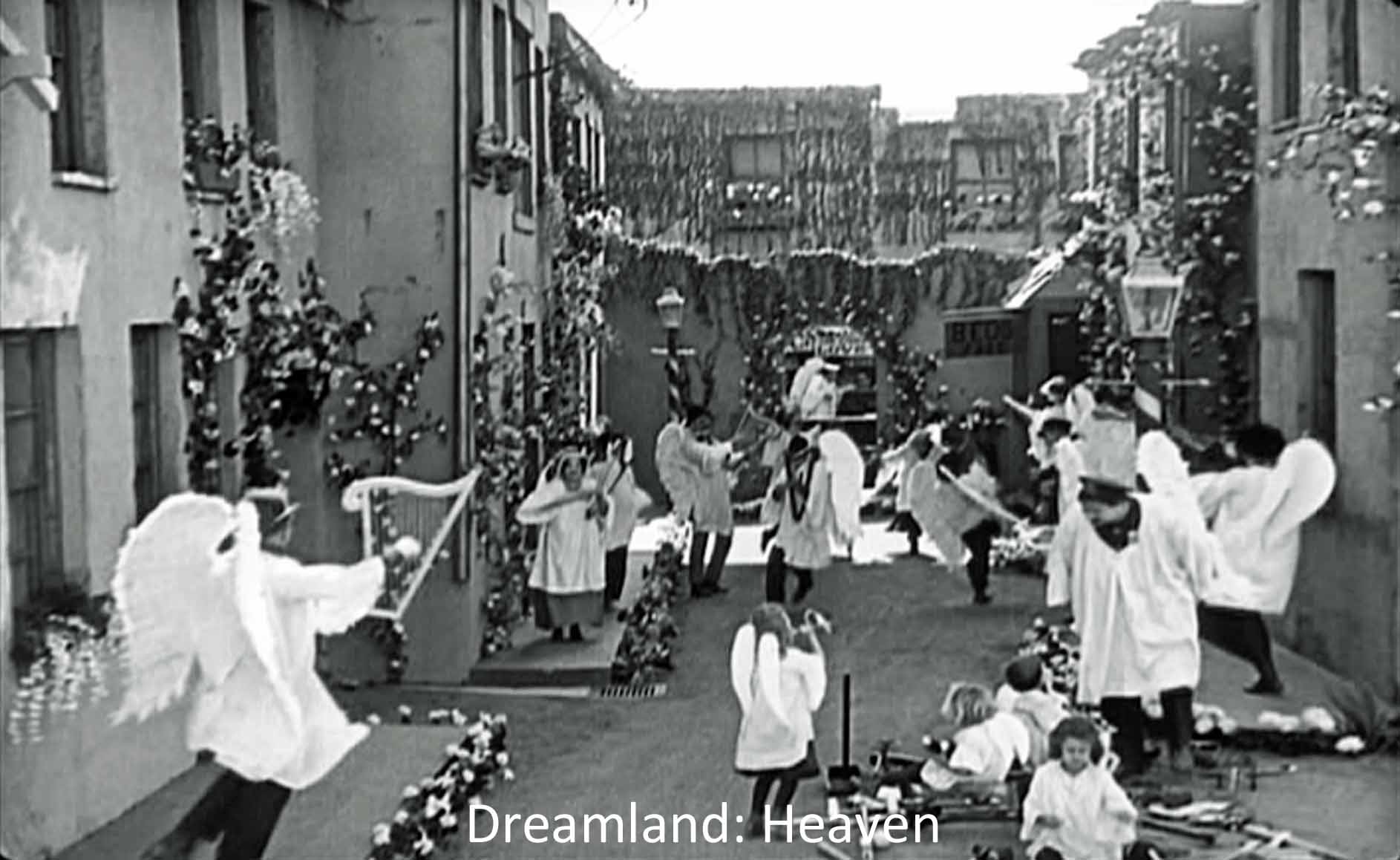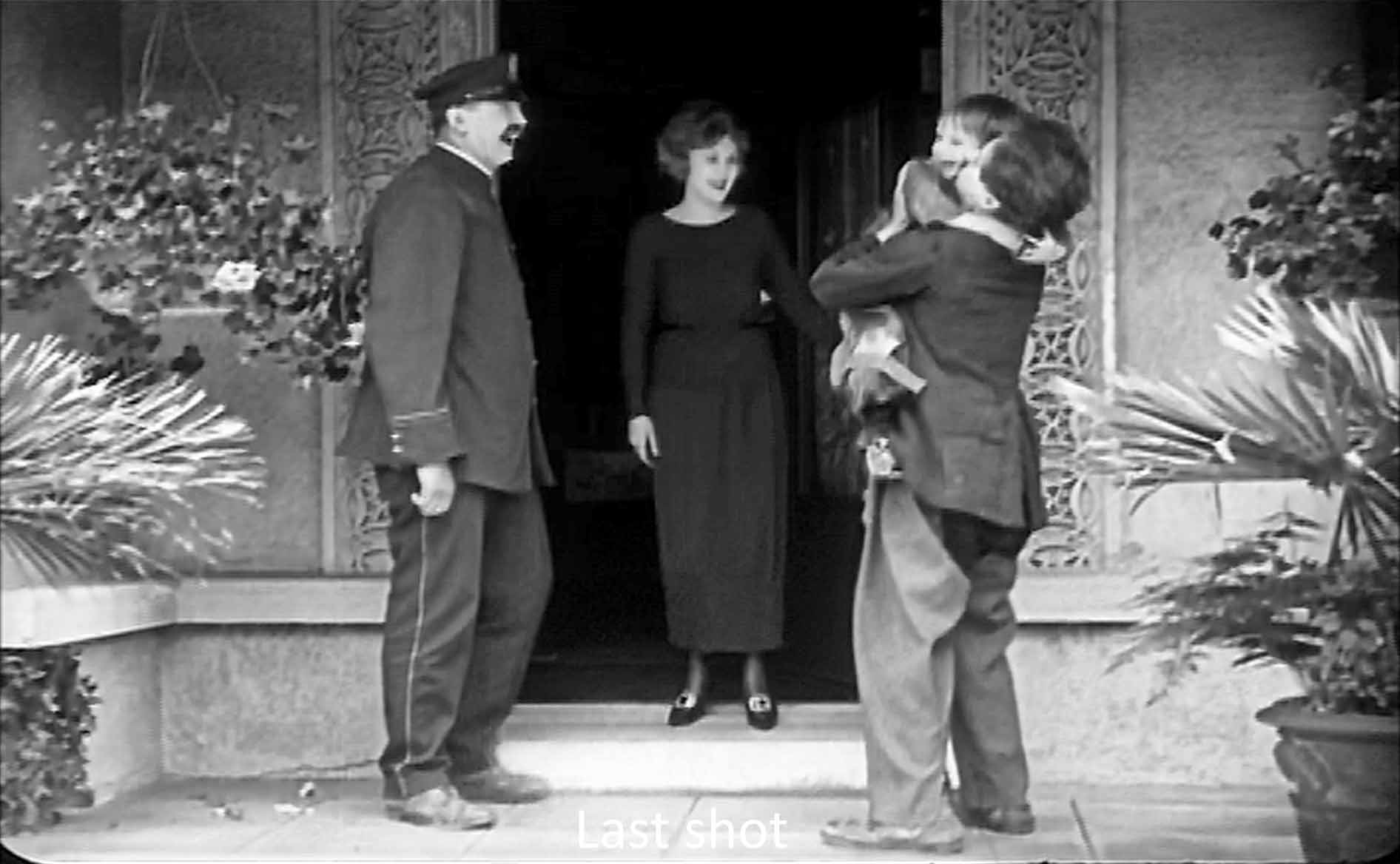One of the delights of silents was Charlie Chaplin’s shenanigans—and one of the afflictions was his clinging to a Victorian sentimentality and religiosity. For example, take the plot of The Kid (Chaplin’s first feature-length film):
“The Woman,” an unwed mother (Edna Purviance) abandons her baby in the back seat of a luxury car—which two thieves then steal, leaving the foundling on a garbage heap. The little tramp (Chaplin) picks it up and, despite valiant efforts to correct his mistake and get rid of it, he ends up assuming responsibility for of the foundling. Five years later, they have a happy household, each cooking for and taking care of the other, making a living by the kid’s (Jackie Coogan’s) breaking windows and Charlie’s repairing them.
The mother, meanwhile, has become an opera star, who mourns her lost child by acts of charity to poor children, among them Charlie’s. One day, the kid (and Charlie) win their fight against two neighborhood bullies, but the kid falls ill. Charlie calls in a doctor (Jules Hanft), the doctor reports the child an orphan, and the county authorities try to carry him off to the orphanage. Charlie fights them off, and he and the kid escape to a flophouse. Meanwhile, the doctor shows the star the note left with the foundling. She recognizes it and advertises for her child. The flophouse owner (Henry Bergman) turns the kid in for the reward, and mother and child are united at the police station.
The tramp, deserted, falls asleep on his doorstep and dreams of an urban Paradise where all the characters of the movie have wings, angelic robes, and total benevolence. Devils get in, however, and prompt a girl (Lila Grey) to “vamp” him. (Sex causes trouble, even in paradise.) The previously benign boyfriend gets jealous. They fight, a cop tries to arrest Charlie and when he flies away shoots him down. The tramp awakes, and the cop drags him away—to the star and the kid who welcome him with delight.
It’s possible to read a film with so incredible and paradisal an ending as something of a Christian allegory. We are, after all, presented with a miraculously adorable child, born of, if not a virgin mother, at least a mysteriously absent father. We see “The Man” (Carl Miller) in one scene, an artist responding to the criticism of an older artist (one of the many authority-figures in this film). He accidentally drops the photograph of the woman he had loved in the fire and indifferently lets it burn. A creator of pictures and babies—and a destroyer, you could read him as a figure for an indifferent god.
Chaplin gives us a much more explicit Christian reference in a pure montage cut (in the manner of Eisenstein or Griffith) from the mother struggling along with her baby to a statue of Christ carrying his cross up a hill. Then we get the two thieves who take the car with the kid in it. Later the mother becomes the very spirit of Christian charity, giving to the poor and quoting the Bible to Charlie and the bully. Typically, Chaplin sentimentally overstates the religious theme.
The rest of the film understates it, as Charlie and the kid say their hurried graces or prayers—which help them not at all in their troubles. Indeed, in the flophouse they lead to the discovery of the kid. And it is hard to credit Charlie’s dream of Heaven with choir robes and great chicken-feather wings, even though in the dream he undergoes a death and rebirth. Shot by the policeman as he is trying to fly away, he dies and awakens to be taken to the real, if earthly, paradise of the mother and child.
Chaplin both overstates and understates his Christian themes, and throughout the film, I see a pattern or rhythm of a thing and its opposite. A psychoanalyst might call this a defense of doing and undoing, in particular, wanting and rejecting, the way I can imagine Chaplin wanting and rejecting religious allegory. The mother wants and rejects: first she abandons the baby, then she decides she wants it. Charlie tries to get rid of the baby, then accepts it. The artist destroys a picture even as he is making a picture. Charlie feeds the child, then makes diapers and a potty. He and the kid live by breaking windows, then repairing them. First Charlie cooks, then the kid cooks. First Charlie wants a hand on his shoulder (when he is flirting with the housewife whose window he has fixed), then he doesn’t (when it is her burly policeman husband). During the big fight scene, the star intervenes with “Turn the other cheek,” but Charlie turns the tables on the bully with a brick. At the theatre a rapturous maestro laughs and cries over the star’s performance. Charlie’s house number is 69. He has angels in his dream, then devils. The very last bit of Chaplinism in the fantasy shows the little tramp walking and unwalking round a post.
Much of this doing and undoing relates to possession. First, somebody wants something, then they throw it away. Or first they don’t want it and then they do.
The artist wanted the woman. Now he doesn’t want her. The first time we see Charlie, people are throwing trash away and it falls on him. He then tosses away the gloves in which he has been preening. The kid puts a quarter into the gas meter and gets it back. Charlie can’t find coins to pay the flophouse keeper, then does. First the flophouse keeper doesn’t want the kid, then does. In the dream sequence, first the bully doesn’t mind Charlie kissing his girl, then he does.
In general, what defines the dreamed Paradise is flowers and feathers, both associated with the star. Flowers in the theater tell us audiences want her. She wears feathers when she finds the kid she longed for. And neither lasts. Flowers fade, and feathers fly away. Just as we keep things and reject them, our possessions reject and keep us.
The theme of possession governs the three major characters. First they are thrown away, then they are wanted. The mother starts as a fallen woman but ends as an admired, rich star. The kid, first thrown away by the mother and by Charlie, ends up wanted by both. Charlie, first a rejected tramp, becomes (if we believe the ending) sought after and wanted.
There are, however, two senses in which people are “wanted.” One can want another out of love, as Charlie and the mother (and we) want the kid. Or one can be “wanted” by the police or the authorities. And there is plenty of that in this movie. Cops, cops, cops. In practically every scene, a policeman appears, often looking over Charlie’s or the kid’s shoulder. If not a cop, a “Charity Hospital” with bars like a prison, or an orphanage, likewise barred. In one of the titles, Chaplin speaks of those for whom “charity” is a “duty,” as opposed to the star and mother, for whom it is a “joy.”
I would put it all together, then, as a movie about the human comedy and tragedy (a title describes this as a film with both a smile and a tear), the way they follow on whether we are wanted or not, and how we are wanted: with love or without it. Like first overstating, then understating, that Christian theme.
In a way, you could say much of Chaplin’s comic style involves just this sort of doing and undoing. As he is taking a morning stroll in his slum, garbage falling on him from the windows above, he comes across a baby in a trashpile. Logically enough, he looks up—to see who threw out this novel bit of trash. Later, trying to get rid of the baby, he lifts up a grating in the gutter, but sagely puts it down again. No, he won’t throw the baby down the storm sewer.
Chaplin’s action makes the tramp’s mental process visible for me. I “read” through the action, undoing its physicality, turning it back into the thought behind it, which Charlie himself then rejects or goes on from. I both get the idea and have it taken away. Both Chaplin and I have it both ways, as when (in, for me, the most moving moment of The Kid) Chaplin kisses the boy tenderly and fleetingly on the lips after they have arrived at the orphanage—and then chases the orphanage’s driver down the street. Pure love, followed by pure aggression.
Perhaps that is the great secret of the Shakespeares, the Bachs, the Rubenses—and the Chaplins. They let us have things without having to have them, really, or the responsibility for them. Like “the kid.” Incidentally, the real “kid,” Jackie Coogan, ended up as the ghoul in the tv series The Addams Family. And that trashy ending and the sentimentality don't finally matter. Chaplin's genius at filmmaking triumphs over it all.
